Book contents
- Frontmatter
- Contents
- General Editors' Preface
- Preface
- List of Abbreviations
- 1 WHAT IS A “THEOLOGY OF GENESIS”?
- 2 ON READING GENESIS 1–11
- 3 GENESIS 1: PICTURING THE WORLD
- 4 GENESIS 2–3: ADAM AND EVE AND “THE FALL”
- 5 GENESIS 4: CAIN AND ABEL
- 6 GENESIS 6–9: CATACLYSM AND GRACE
- 7 ON READING GENESIS 12–50
- 8 GENESIS 12:1–3: A KEY TO INTERPRETING THE OLD TESTAMENT?
- 9 GENESIS 12:3A: A BIBLICAL BASIS FOR CHRISTIAN ZIONISM?
- 10 GENESIS 22: ABRAHAM – MODEL OR MONSTER?
- 11 ABRAHAM AND THE “ABRAHAMIC FAITHS”
- 12 GENESIS 37–50: IS JOSEPH WISE?
- Further Reading
- Author Index
- Scripture Index
- Subject Index
6 - GENESIS 6–9: CATACLYSM AND GRACE
Published online by Cambridge University Press: 05 June 2012
- Frontmatter
- Contents
- General Editors' Preface
- Preface
- List of Abbreviations
- 1 WHAT IS A “THEOLOGY OF GENESIS”?
- 2 ON READING GENESIS 1–11
- 3 GENESIS 1: PICTURING THE WORLD
- 4 GENESIS 2–3: ADAM AND EVE AND “THE FALL”
- 5 GENESIS 4: CAIN AND ABEL
- 6 GENESIS 6–9: CATACLYSM AND GRACE
- 7 ON READING GENESIS 12–50
- 8 GENESIS 12:1–3: A KEY TO INTERPRETING THE OLD TESTAMENT?
- 9 GENESIS 12:3A: A BIBLICAL BASIS FOR CHRISTIAN ZIONISM?
- 10 GENESIS 22: ABRAHAM – MODEL OR MONSTER?
- 11 ABRAHAM AND THE “ABRAHAMIC FAITHS”
- 12 GENESIS 37–50: IS JOSEPH WISE?
- Further Reading
- Author Index
- Scripture Index
- Subject Index
Summary
Although the story of Noah and the Flood (Genesis 6:5–9:17) is one of the most famous of biblical stories, an understanding of its theological significance is hardly self-evident or straightforward. Moreover, although it is one of the first biblical stories that many children encounter, through picture bookswith colorful depictions of paired animals in proximity to a houseboat, it is a story that at the present time is generating high levels of unease as to its nature as a religious text and its suitability even for adults, never mind for children.
Richard Dawkins, for example, says,
The legend of the animals going into the ark two by two is charming, but the moral of the story of Noah is appalling. God took a dim view of humans, so he (with the exception of one family) drowned the lot of them including children and also, for good measure, the rest of the (presumably blameless) animals as well.
Although, as will be seen, this account of the story's “moral”
hardly reflects an attentive reading of the text, Dawkins' attitude is representative of a widespread contemporary sense that the Bible is a far more problematic and dangerous text than has sometimes been allowed by those who revere it as holy scripture.
Within modern scholarship, although the moral and theological significance of the Flood story has not been neglected, it has usually been considered primarily in conjunction with two other debates about the text: on the one hand, the mode of telling of the Flood story, and, on the other hand, the significance of the nineteenth century discovery of a strikingly comparable account within the Epic of Gilgamesh.
- Type
- Chapter
- Information
- The Theology of the Book of Genesis , pp. 102 - 120Publisher: Cambridge University PressPrint publication year: 2009



